Live Streaming CDNs – What Broadcasters Need to Know in 2025
Live streaming video CDN is one technology that works behind the scenes to ensure viewers enjoy uninterrupted viewing. Therefore, it’s vital to have a basic understanding of technologies such as real-time CDNs that make smooth content delivery possible.
Your viewer’s experience, on the whole, ultimately decides the popularity of any broadcaster. Unfortunately, one thing that turns viewers off is lagging and buffering. In the era of instant gratification, the buffering wheel caused by your local network often prompts your viewers to switch to other streams rather than waiting it out.
Live-streaming video CDNs help accelerate the video delivery process.
A CDN is a group of geographically distributed streaming servers. They catch internet content, such as your videos, from a location closest to the person trying to view your content. That helps speed up the delivery process of your high-quality videos to your viewers better than your local network.
There are many possible live streaming platforms on the market that streamline online broadcasting, but you’ll also need to consider the technical elements of content distribution.
In this post, we will discuss the value of CDNs for live-streaming before we compare 10 of the top live-streaming CDN providers on the market. Finally, we’ll wrap things up by looking at four video hosting platforms with reliable CDN partnerships.
Table of Contents
- What Is a CDN?
- How CDNs Work
- Types of CDNs
- What Are the Benefits of a Live Streaming CDN?
- Live Streaming Content Delivery Networks and Video Hosting
- How to Access a Powerful Live-Streaming CDN
- Live-Streaming CDN Providers Comparison
- Top Video Platforms With Live Streaming Video CDN Partnerships
- Choosing the Right OVP With a Top-tier Live Streaming CDN
- FAQs
- Conclusion
What Is a CDN?


A content delivery network (CDN) is a network of servers and data centers spread around the globe. They are essentially cell phone towers for video content. Each network location caches content, which is a fancy way of saying that they take your data, in this case, your video content, copy it, and store it at all their locations.
Why does that matter? A CDN shortens the distance between your content and the end user. The shorter the distance your content travels between where it is stored and the end-user, the faster the content will get to them. A short travel distance also preserves the quality of the content.
The terms “content delivery network” and “content distribution network” can be used interchangeably.
Today, video streaming CDNs deliver a large portion of the data sent over the internet at any moment. Businesses usually rely on CDNs for their content delivery needs due to the hefty cost of employing worldwide servers.
How CDNs Work
A CDN can deliver content, not just media files. Content that’s sent through CDNs includes:
- Videos
- Images
- Text
- Other data
Video CDNs are most often used to distribute large media files. A content delivery network uses a widely distributed network of live-streaming servers for your content.
Viewers who request content from a CDN are automatically routed to the closest server, called the “edge” server. A viewer’s IP address generally dictates the caching servers to which they’re directed from the origin servers.
The further a user is from the origin server, the potential for latency increases. A top-tier CDN reduces buffering and maximizes the quality of secure live video streaming.
The streaming speed is about more than just one’s internet connection speed. Content delivery speeds are also determined by the number of “jumps” content has to make en route. When an old distant server hosts content, it loads slowly, no matter how fast the internet connection is at the destination.
A high-quality CDN can revolutionize and streamline the download process. That way, you can focus on creating high-quality content for your viewers!
Types of CDNs
Depending on your streaming needs, you can choose various types of CDNs. These include:
- Peer-to-Peer (P2P) Network CDNS: P2P CDNs do not have a static or any globally routed IP address. They’re widely deployed, with a huge number of them, to mitigate the impact of a single server failure. P2P CDNs are extremely decentralized and there may be security problems connected with this strategy.
- Private model CDNs: these are owned and maintained by individual companies. As such, these CDNs are protected and not decentralized as with P2P CDNs.
- Push CDNs: This is best when you want to control traffic on your network. Here, the primary server or user pushes the content to a CDN, which acts as a secondary server.
- Origin pull CDNs: Here, the CDN pulls content from the origin server and delivers it to the end user. These are easier to set up and take up less storage space.
What Are the Benefits of a Live Streaming CDN?
Working with a CDN benefits a business wanting live-stream video content. The main benefits of CDN live streaming are increased speeds and reduced buffering, the ability to create redundancy, increased resilience, and scalability.
Increased Delivery Speeds
With a CDN, your content gets to your end-user faster. With live streaming content, a CDN helps your end-user experience the event as close as possible in real-time.
Reduced Buffering
A little spinning buffering wheel brings one back to the days of dial-up internet. It’s frustrating and not something viewers will deal with for over a few seconds. With CDN, buffering can be significantly reduced and, in some cases, eliminated for your streaming content.
Increases Engagement
As a broadcaster, you spend a lot of time and resources on creating interesting live streams and spend on SEO to make sure your content ranks high on search engines. Your website shows promising numbers, yet most of these viewers seem to drop off without engaging with your content.
That’s a somewhat familiar problem many broadcasters face. The culprit is usually slow-loading content. Even though you’re piquing the audience’s interest, they get discouraged by the slow speed and leave without giving you the views and engagement you work so hard for. By using a CDN video hosting platform for your live streams, you help reduce load time. That helps reduce the drop-off rate and prompt viewers to engage with your content.
Better Resilience
You don’t want your stream to go down while live-streaming an event. When you work with multiple video CDNs, you can increase the resilience of your content, ensuring that if one server fails, another is there to get your content to your viewers.
Thanks to many geographically distributed servers, proxy servers are on standby anytime. Multi-CDNs use multiple servers to increase the resilience and dependability of your VOD content.
Scalability
With streaming CDNs, it’s easier to scale your content than if you were hosting the content on your own servers. Your small servers may crash if your content goes viral and demand suddenly increases.
Live streaming content delivery networks reduce costs and technical overhead. Building your global network of servers to deliver your content to users would require a great deal of expense (hardware, electric costs, maintenance, etc.) and a dedicated, round-the-clock staff.
You’re renting access to a global network of high-performance and professionally built servers by choosing an integrated streaming solution.
That way, broadcasters can access speed, reliability, security, performance, and more without the attendant costs and network congestion. That way, your business can focus on more significant problems instead of worrying about content servers crashing when users access viral content.
Less Transit Time
In addition to reducing buffering and providing a better viewing experience for your global audiences, video CDNs reduce the time it takes for your content to reach your audience. CDNs help load web pages and make transitions quicker by rerouting viewers to the closest server.
Business-Specific Benefits
Besides the main benefits mentioned above, here are a few business-specific benefits of efficient content delivery
- Speed: CDN delivers speedy content for the end-users.
- Customer satisfaction: The speedy delivery of content increases customer satisfaction and, in turn, can drive more sales for online businesses.
- Higher traffic support: Your business website can sustain higher traffic with a CDN’s load-balancing capacity.
- Audience segmentation: Segmenting your audience with the data gathered from your CDN network becomes easier once you know their location.
- Storage and security: CDNs offer secure storage capacity for content such as videos for enterprises, as well as archiving and data backup services.
Businesses can enjoy additional benefits that are important to consider if broadcasting content is essential to your overall business strategy or structure.
Imagine live streaming from a single server, and your content suddenly goes viral. All at once, ten thousand people request data from your origin server, overloading your machine and causing it to crash. At that point, no one can access your stream.
That’s a disastrous video distribution scenario, especially for monetized streams.
With a live-streaming CDN, the server network distributes loads across dozens, hundreds, or thousands of servers.
That means video content can be reliably delivered to thousands or millions of viewers without interruptions. For professionals, that reliability is essential, especially regarding scalability.
Live Streaming Content Delivery Networks and Video Hosting
Watching video content through any website involves a server. Here’s how it works:
Your computer sends a signal to a server requesting content, which gets delivered to you. You know that a CDN comprises hundreds, if not thousands, of these dispersed streaming servers. The same thing goes for video hosting platforms. While you may not see a connection, there is.
While you can host videos online for free on YouTube, you’ll want a more professional streaming solution as a business. The dedicated online video streaming service you choose will provide a network of computer servers to store your video content. It also provides a robust network connection so viewers can easily access the videos without network lag.
Businesses need the best options for remote video strategy. Your growth will be limited if you stick to the free public platforms. However, if you use a secure video hosting platform, your growth can continue, and there’s no stopping you.
Many top video hosting solutions use HTTP live streaming (HLS), supported on iOS, Android, Mac, Windows, Linux, and almost every modern platform. It doesn’t require a plugin but instead uses built-in HTML5 browser functionality. HLS streaming via an HTML5 video player is now the preferred method for video playback.
In 2019, over 79% of all global consumer web traffic came from video, most likely from HTML5. That figure will continue to grow in 2024.
Given that trend, HTML5 and mobile-compatible live streaming are essential for businesses.
Dacast provides an HTML5 player that can be embedded in any website or app. This video player is white-label and fully customizable to add your company’s branding, colors, and more. You can use cutting-edge technologies and long-established standards to deliver content and videos.
How to Access a Powerful Live-Streaming CDN


There are many different ways to access a live-streaming content delivery network CDN. For one, you could set up a deal yourself. Larger streaming customers generally work with petabytes of data and spend tens of thousands of dollars on bandwidth.
Alternatively, many CDNs now offer pay-as-you-go contracts for smaller users. These are usually billed for bandwidth on a per-GB basis. If you have media files on your servers, you can connect them to a live-streaming video CDN if you expect significant traffic.
However, the topic becomes more complex when dealing with live-streaming video distribution as the technical setup is relatively intricate.
In recent years, more CDNs have made it easier for businesses to distribute video content via live streaming over their network, without over-burdening their core network. Still, the best way to access a powerful CDN provider is via a video streaming platform.
Finding the Right Live Streaming CDN to Use
Which live video CDN is right for you? That depends on factors such as the traffic your live streams get and the part of the world your audience belongs to. The great news is that you have multiple choices available today. With the explosion of the internet and online video content, many CDNs provide web infrastructure video distribution services today.
Each CDN has a different focus and strength. Some focus on specific geographic regions. Others specialize in different types of content.
As a business, your choice will be based on the needs of your specific goals and business model. You have to consider features, reliability, and CDN pricing.
Live Streaming CDN Providers Comparison
Each CDN provider differs slightly regarding functionality, feature offerings, and pricing. Let’s look at 10 of the top live-streaming CDN providers on the market.
1. Akamai
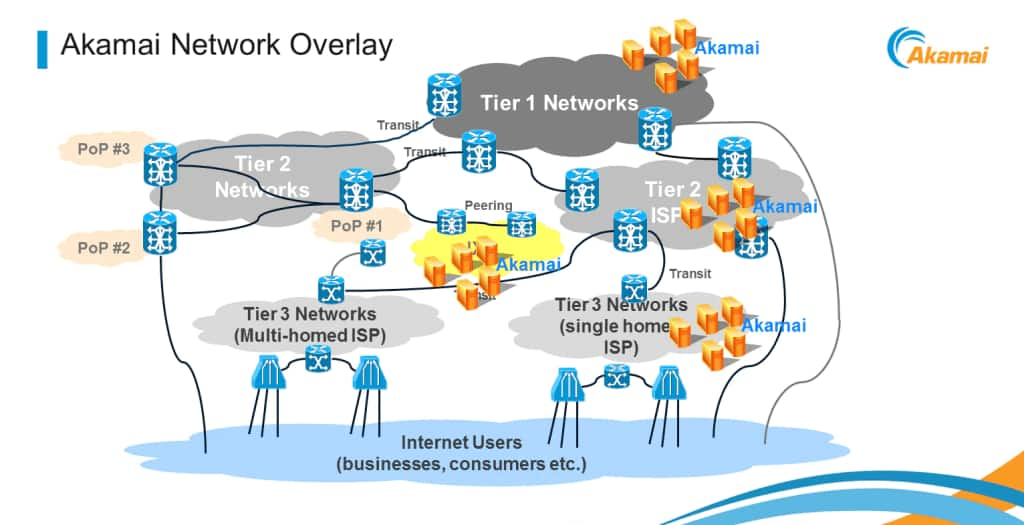

Akamai is one of the oldest CDNs in the world and one of the platforms Dacast partners with. It’s also the most extensive network, with over 240,000 servers in more than 130 countries.
A behemoth in the industry, Akamai delivers between 15-30% of all web traffic. A whopping 96 out of the top 100 retailers in the U.S. rely on Akamai for content delivery. Major Akamai customers include Apple, Facebook, Twitter, Google, and Healthcare.gov. That makes Akamai the largest single CDN content delivery network in the world. Collectively, this infrastructure delivers 30 Terabits of data per second.
The Akamai platform supports live streaming and on-demand video hosting. They provide several other features, including analytics, video security, privacy settings, HTML5 video content delivery, and support for a wide range of codecs and protocols.
Key Features
- Akamai CLI
- Case Management
- Certificate Provisioning System
- China CDN Manager
- Content Control Interfaces
- CP Codes and Reporting Groups Tool
- Diagnostic Tools
- Firewall Rules Notification
- Identity and Access Management
- Log Delivery
- Property Manager API
- Sandbox Environment
Pricing
Akamai pricing is customized for each user based on the features they need, the size of their business, bandwidth requirements, and other factors. Contact sales to work out the most suitable configuration and pricing for your business.
2. Edg.io (Formerly Limelight)
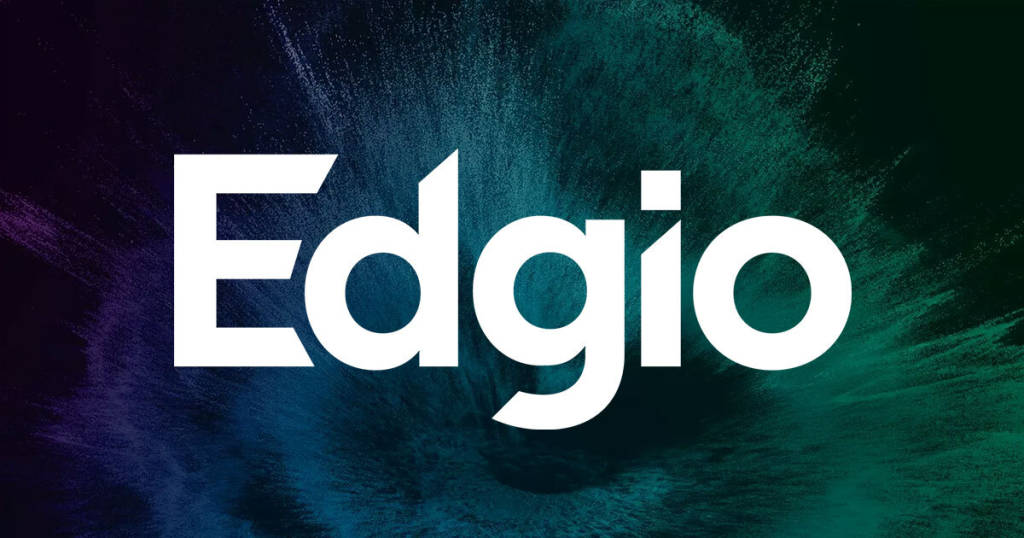

The newly created Edg.io is an industry leader in edge access and Content Delivery Services that provides powerful tools and a customer-first approach to optimize and deliver digital experiences at the edge. As a trusted partner of the world’s biggest brands, it provides global clients with live stream experiences like sports, global movie launches, video games or file downloads for new phone apps.
Key Features
- CDN balancing tech
- Video on demand (VOD)
- Live video streaming
- RTMP streaming
- Shared SSL certificates
- Large file delivery
- Small file delivery
- GZIP Compression
- Mobile acceleration
- Cloud storage
- Security
- Real-time analytics
- Edge delivery
Pricing
Edg.io does not publish pricing.
3. Microsoft Azure CDN
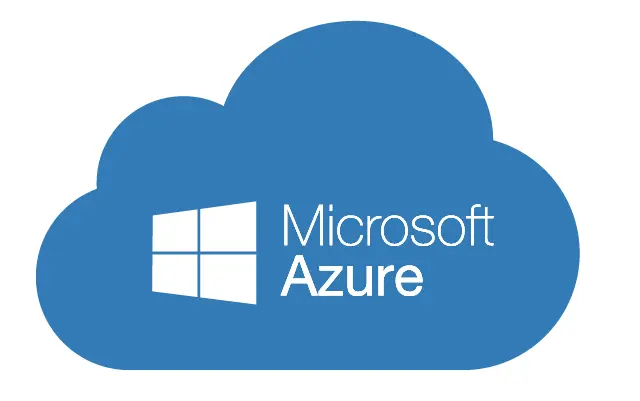

Hailing from the Microsoft technology powerhouse, Microsoft Azure is a streaming content delivery network broadcasters rely on for global content delivery. This live-streaming video CDN is easy to set up, which makes it suitable for beginners. Azure also uses a pay-as-you-go pricing structure, which makes it a good choice for broadcasters with a wide variety of budgets.
Microsoft Azure brings together the support of other top-tier content delivery networks, including some mentioned on this list. We’d also like to point out that Microsoft Azure delivers video, among other media types.
Key Features:
- Reliable security
- Scalable, global delivery
- Bandwidth analytics and monitoring
- Several options for integrations
- Capable of handling high-capacity delivery
Pricing:
Microsoft Azure uses a complex pricing structure based on zones and usage. We recommend checking out their pricing page to learn more about costs based on your unique broadcasting needs.
4. Cloudflare


Next, let’s take a look at Cloudflare. Cloudflare is a growing streaming content delivery network with widely distributed Point of Presence (PoP) worldwide. PoP is an artificial demarcation point or interface point between communicating entities.
Their video hosting offering incorporates excellent features, including cloud encoding and customizable HTML5 video players. They also support API access.
Key Features
- Globally load-balanced
- Static content caching
- Instant full cache purge
- Min cache TTL expiry
- Custom cache keys
- Argo smart routing
- China delivery
- Accelerated Mobile Links (AMP)
- Async JavaScript Loading with Rocket Loader
- Mobile optimization
- CNAME setup
- Key-value storage with workers
Pricing
Cloudflare has simple, transparent pricing plans. Their packages have four tiers:
- Free plan: available for personal websites but doesn’t support video hosting.
- Pro plan: $25/month (or $20 when billed annually)
- Business plan: $250/month (or $200 when billed annually)
- Enterprise plans: these plans are also available with customized pricing per business, and are billed annually
5. Fastly


A proven, cutting-edge CDN provider, Fastly is renowned for real-time content delivery and low-latency streaming. It supports major HTTP video formats, ensuring seamless live, linear, and on-demand video delivery.
With dynamic site acceleration and live event monitoring, Fastly offers reduced latency and flawless streaming experiences. It’s also secure, thanks to robust TLS encryption.
Key Features
- Lightning-fast delivery
- Real-time bandwidth analytics
- API access for customization
- Unique computing code
- Fast loading video
- Cache-control and purging
Pricing
Fastly prices their services based on the region where you’re streaming to. For example, streaming to North America is $0.12/GB for the first 10 TB, $0.08/GB for the next 10 TB, and $0.0075 per 10,000 requests.
Please check out the Fastly pricing page for a complete list of bandwidth and request costs for other regions.
6. CloudFront
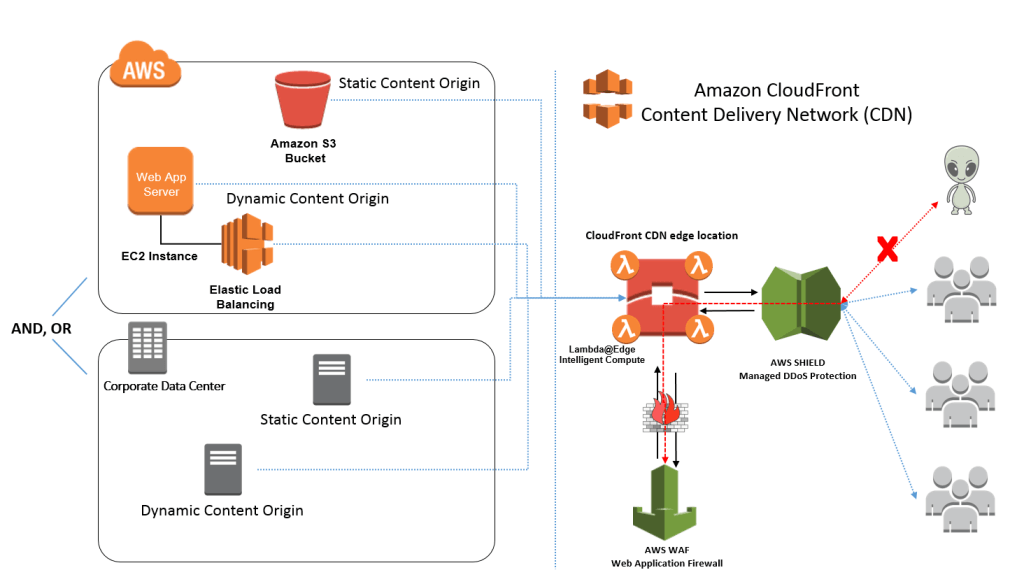

CloudFront is the video CDN offering from Amazon’s Web Services division. CloudFront has servers in 50 countries, a relatively small number compared to 130+ countries when you look at Akamai. The United States, Canada, Europe, Asia, and South America have good coverage. However, there’s limited coverage in Africa, with only 3 countries covered and no Regional Edge Caches.
That can impact your live stream’s performance, especially if you’re hosting a global event. Overall, Cloudfront tends to be 14% slower than Akamai. That’s valuable information for your online video content’s smooth and high-performing delivery.
Their service is popular and widely used for hosting large downloads and web files. It also supports video streaming, both live and on-demand. CloudFront’s system is basic, but you can build on your features using external tools and API.
Key Features
- Global edge network
- Security protection against network and application layer attacks
- Edge computing
- Real-time metrics and logging
- DevOps friendly
- Full-featured APIS and DevOps tools
- Cost-effective
- Free data transfer between AWS Cloud Services and Amazon CloudFront for origin server fetches
Pricing
CloudFront pricing is on-demand based on geographic region, bandwidth usage, and the needed features. CloudFront offers three tiers:
- Always Free Tier, which allows 1 TB of transfer-out data and 10,000,000 HTTP(s) requests per month
- On-demand pricing tier based on data transfer out (internet/origin) and HTTP/HTTPS requests
- Discounted pricing tier for customers who are willing to make certain minimum traffic commits (typically 10 TB/month or higher) for 12 months or longer
7. CDN77


CDN77 offers access to a video CDN and advanced cybersecurity services. CDN77 supports both security and video content delivery.
The company is trusted by significant video creation and distribution companies like TedX, Udemy, and Eleven Sports.
CDN77 is so popular because it’s reliable, secure, and scalable, making it desirable to broadcasters.
Key Features
- Redundant content delivery.
- Tools for secure delivery.
- Smooth delivery.
- Scalability.
- CDN management.
Pricing:
Here are CDN77’s standard pricing options:
- 6 TB of monthly traffic for $199 ($0.033/GB for overages)
- 25 TB of monthly traffic for $385 ($0.015/GB for overages)
- 50 TB of monthly traffic for $580 ($0.012/GB for overages)
- 100 TB of monthly traffic for $990 ($0.010/GB for overages)
- 150 TB of monthly traffic for $1,390 ($0.009/GB for overages)
Custom monthly plans are available for 150 TB to 50 PB of monthly traffic, and high volume plans for 50PB+ traffic.
8. Leaseweb


Leaseweb offers a wide variety of digital services, including content delivery. The platform offers access to both private live-streaming CDNs and multi-CDNs. This content delivery company was founded over two decades ago, making it a longtime player in the content delivery game.
The Leaseweb CDN is pretty standard in terms of video CDN functionality. It simply delivers video content to viewers around the world.
Key Features
- Reliable security
- Global delivery
- 43 PoPs and 29 internet exchanges
- API access
- Support for private delivery through your own servers
Pricing
Leaseweb’s Multi-CDN pricing has a minimum requirement of €150/month (annual contract) and is broken into:
- Multi-CDN Volume: Starting from $7.13 for 50TB traffic/month
- Multi-CDN Premium: Starting from $9.19 for 100TB traffic/month
9. KeyCDN


With KeyCDN, you get an enterprise-grade globally distributed network of edge servers designed to minimize lag and buffering.
KeyCDN optimizes live event delivery through features like optimized HLS and adaptive bitrate streaming, as well as redundant infrastructure.
Key Features:
- Top-notch security
- High availability and global reach
- HTTP/2 support for accelerated delivery
- Origin Shield and DDoS protection
- Brotli and Gzip compression
- Real-time analytics
- API integration
- Instant purge
- Custom TLS
Pricing:
KeyCDN has a pay-as-you-go pricing model for up to 100 TB/month, which depends on zones and storage. Discounted volume pricing is available for over 100 TB/month.
10. Sucuri


Sucuri is another great live-streaming CDN. This platform offers software for content delivery and security. Sucuri has advanced firewalls that keep your content out of the wrong hands.
This streaming CDN uses PoPs strategically placed worldwide to deliver high-quality content near and far.
Key Features:
- Website security support
- Website firewalls
- Reliable, global content delivery
- Adequately spaced PoPs
- Tech support by ticket
Pricing:
Securi has four pricing plans with different scan frequencies. Content delivery is included with each plan. Here’s how they are laid out:
- Basic: $199.99/year; security scans every 12 hours
- Pro: $299.99/year; security scans every 6 hours
- Business: $499.99/year; security scans every 30 minutes
Broadcasters can also opt for custom plans. These plans come with unlimited customer support and can be used for multiple sites.
Top Video Platforms With Live Streaming Video CDN Partnerships
For most broadcasters, the online video platform (OVP) they choose integrates a live-streaming CDN into its platform. Since this is the case, working directly with a CDN for live streaming generally doesn’t make sense unless you’re a larger-scale enterprise.
We recommend doing some research to choose the right video host that offers a full-service solution. A single platform with a monthly fee, like Dacast, can handle many or all of your needs in-house. These might include video hosting, distribution, CDN services, API access, video player, monetization, etc. Since you depend on a single service to do all these things, choosing the right video hosting platform goes a long way.
That said, let’s take a look at four video platforms with reliable live-streaming CDN partnerships.
1. Dacast
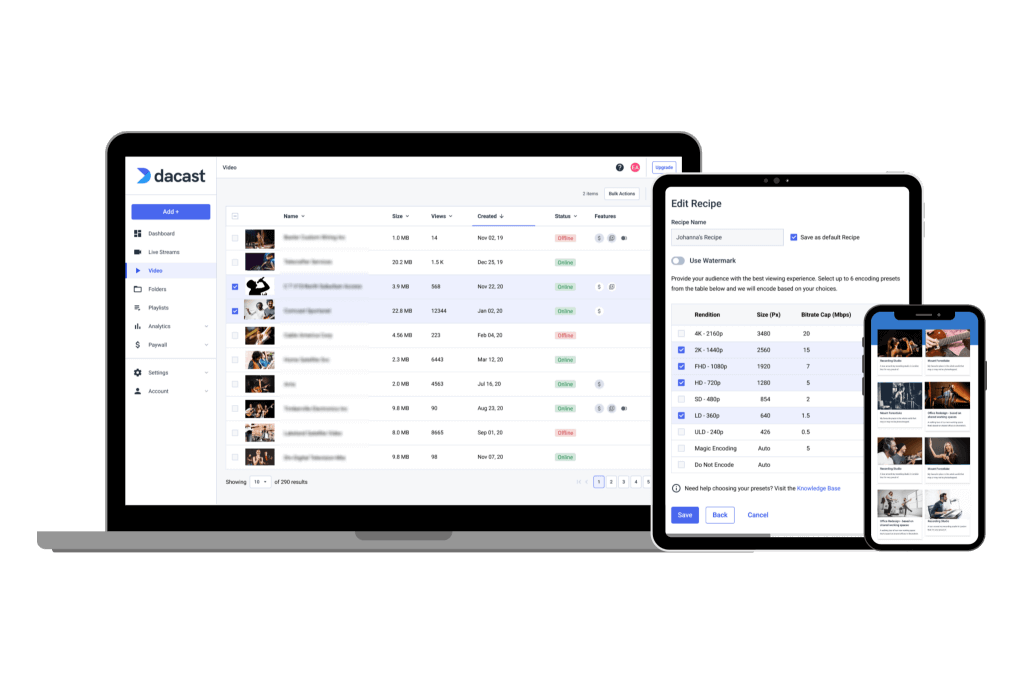

Let’s examine our video hosting and live-streaming solution. Dacast partners with several top-tier CDNs, including Akamai and Limelight.
Our streaming solution includes various security features, 24/7 customer support, and an easy-to-use live streaming platform. All of this is available through every plan level. Dacast also uses an HTML5 video player to provide a better performance, which you can customize to your needs.
Key Features
- Live streaming and Video on Demand are included in all plans
- Unlimited viewers and live channels
- Video transcoding for true adaptive bitrate streaming
- White label and branding control
- Embeddable HTML5 video player
- Secure, global content delivery, including industry-best video hosting
- RTMP (real-time messaging protocol) ingest, playback, and streaming support
- 24/7 tech support with all plans, including email and live chat
- Video security features, including password protection and AES encryption
- M3U8 media links to stream to mobile and smart TV apps such as Roku, Apple TV, etc.
- Player API and Video API access
- Multi-bitrate streaming
- Real-time analytics
- Ad-free streaming
New!
- M3U8 file creation capability to enable adaptive streaming delivery of OTT video content across various devices
- Fully integrated RTMP streaming platform features
- Advanced API to build your own video CMS
- AES video encryption for advanced streaming security
- Multi-user access (MUA) on Scale and Custom plans
- Zoom live streaming integration for meetings and live events in real-time
- Expo 2.0 galleries video portal for immersive video experiences
- Authenticate-only paywall for no payment content gating
- Plays by Location geographical insight
- Multi-CDN streaming for high-quality broadcasts
- Browser-based live streaming with WebRTC
Pros
- Live streaming and VOD packages on all pricing plans
- Unlimited viewers and live channels
- White label and branding control
- Embeddable HTML5 video player
- SVOD, AVOD, and pay-per-view TVOD monetization options
- Mobile device support
- Live stream recording
- China Video Hosting
- Plans for every budget
Cons
- Takes a little bit of time to learn all of the features
Upload Guidelines and Specs
- Minimum dimension: None (but 240p is the recommended minimum)
- Maximum dimension: 1080p or 4K (depends on the user’s hardware and internet)
- Aspect ratio: No restrictions (but 16:9 is the default)
- Max file size: None
- Max video length: None
- Total file storage: 10-1000 GB (depends on plan)
- Compatible video formats: MP4 (preferred), MOV, M4V, M2V, AVI, MPG, FLV, WMV, MKV, WEBM, OGV, MXF, ASF, VOB, MTS
Pricing
Live streaming with Dacast comes at four levels. The video streaming pricing plans include:
- Starter plan: ideal for newcomers with 2.4 TB of bandwidth and 500 GB of storage per month, at just $39 per month, billed annually.
- Scale plan: includes 24 TB of bandwidth per year, with 2000GB of storage for$250 per month or $165 per month billed annually. These Scale pricing plans add phone support, a monetization paywall, an M3U8 online player for live channels, ad insertion, a white-label video player, and video API access.
- Event plan: for organizations who’d rather not sign a contract and want to purchase bandwidth separately to live stream an event. It offers 6 TB of bandwidth upfront, 250 GB of storage, and costs just $63 per month (or $750/year). Additional data and storage can be added as needed.
- Custom plan: if your enterprise business has high-volume streaming needs, you can contact Dacast for a custom plan tailored to your needs.
For even more advanced VOD features, including China video hosting, current Dacast users can learn more about upgrading here.
2. Wowza
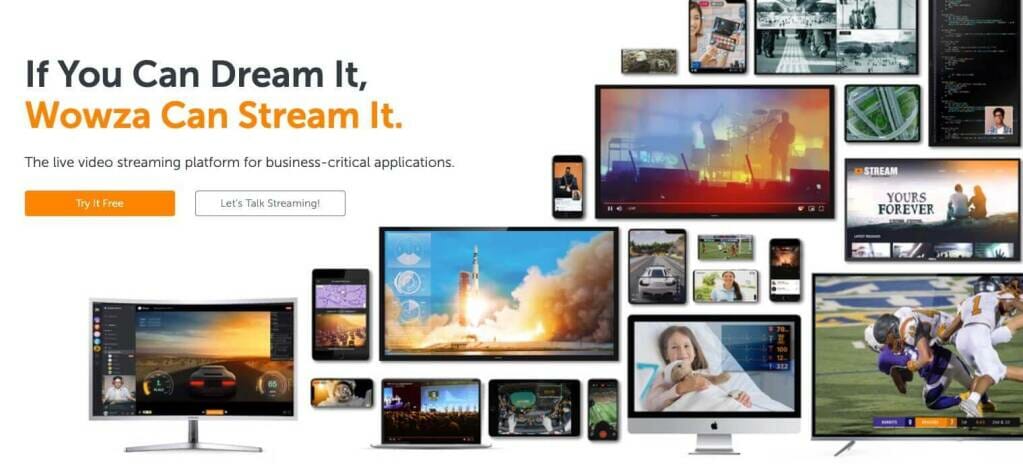

Next, let’s take a look at Wowza Media Systems. Wowza is an online video platform that provides products and services widely used in the streaming video industry. This includes Wowza Streaming Cloud, their video hosting, and a streaming platform.
Streaming Cloud includes support for both live and on-demand video. The service includes features such as full HD streaming, low latency live streaming solutions, and security access features. It also offers video API access and uses Akamai’s network as well.
Key Features
- Cloud transcoding
- Live streaming and VOD hosting
- White-label video player for advanced customization
- HTML5 video player for all-device video streaming
- API access
- Top-notch customer support
Pros
- APIs are available
- Live stream recording
- Cloud management portal
- 4K streaming
- Wide range of security options
Cons
- No simulcasting tools
- Lack of video monetization and audience analytics tools
Upload Guidelines and Specs
- Minimum dimension: 240p (320 x 240)
- Maximum dimension: 4K (3840 x 2160)
- Aspect ratio: 16:9, 4:3
- Max file size: Not available
- Max video length: Not available
- Total file storage: 250 GB (depends on the plan)
- Compatible video formats: MP4, FLV, MP3, SMIL, AMLST, ID3, NGRP
Pricing
Wowza recently overhauled its pricing plans and added several options. These are split into 2 main tiers: Wowza Video (Cloud Streaming) and Wowza Streaming Engine (Private Cloud & On-Prem Streaming).
The Wowza Video Cloud Streaming offers 3 pricing plans:
- One Month of Streaming: $149 one-time purchase; includes 15 hours of live streaming and 500 viewing hours
- Pay as you go: $0/month; $2.50/hour of streaming, all usage billed separately
- Enterprise: Annual plans built for your needs; contact sales for custom pricing
All of these Live Event plans reflect the rate when paid monthly and include full brand control, multi-bitrate streaming, and UHD and HD streaming.
The Wowza Streaming Engine has its own pricing plans, which include:
- One Month of Streaming: $295 one-time purchase + $295month for each additional instance
- Basic Monthly: $195/month + $195/month for each additional instance
- Enterprise: Please contact Wowza directly for access to their custom-tailored high volume enterprise solutions
3. IBM Cloud Video


IBM Cloud Video came about after the acquisition of Ustream by IBM several years ago.
Today, IBM Video Streaming offers a range of services, including video hosting and live streaming via “Streaming Manager.”
Key features of the IBM Video Streaming platform include custom branding on higher-priced plans, password protection, and an HTML5 video player. The service also includes HD broadcasting up to 720p resolution with a full 1080 supported only on Enterprise plans.
Key Features
- Reliable platform
- Stellar customer support.
- An internal content delivery server
- Built for enterprises and large organizations
Pros
- Professional platform
- Great for professional broadcasters
- Reliable technical support
- Equipped with powerful features for broadcasters
- Hong Kong (China) video hosting
Cons
- Only ad-based monetization
- Some limitations with the internal content delivery server
- Some important features only available with high-ticket plans
Upload Guidelines and Specs
- Minimum dimension: 480p (480 x 270)
- Maximum dimension: 4K (3840 x 2160)
- Aspect ratio: No published aspect ratio
- Max file size: 4 GB
- Max video length: No published limits
- Total file storage: 1TB – 5TB (depends on plan)
- Compatible video formats: MKV, MP4, MOV, FLV, AVI, WMV, MPEG2, H264, H263, MPEG4, VP6, VP8, THEORA, WMV, MP3, AAC-LC, NELLYMOSER, PCM, SPEEX, VORBIS, WMA
Pricing
The pricing plans for the IBM Cloud Video include:
- Start Trial – Video Streaming: Give it a free test drive for 30 days
- Silver: Affordable Essentials, 100 viewer hours, 5 channels, 1 TB video storage, starting at $145/month
- Gold: Standard business features, 2,000 viewer hours, 10 channels, 2 TB video storage, starting at $729/month
- Platinum: Premium Volume scale, 5,000 viewer hours, 20 channels, 5 TB video storage, starting at $1,460/month
- Custom: Please contact IBM Cloud video for custom plan pricing as well as payment plans
4. Vimeo
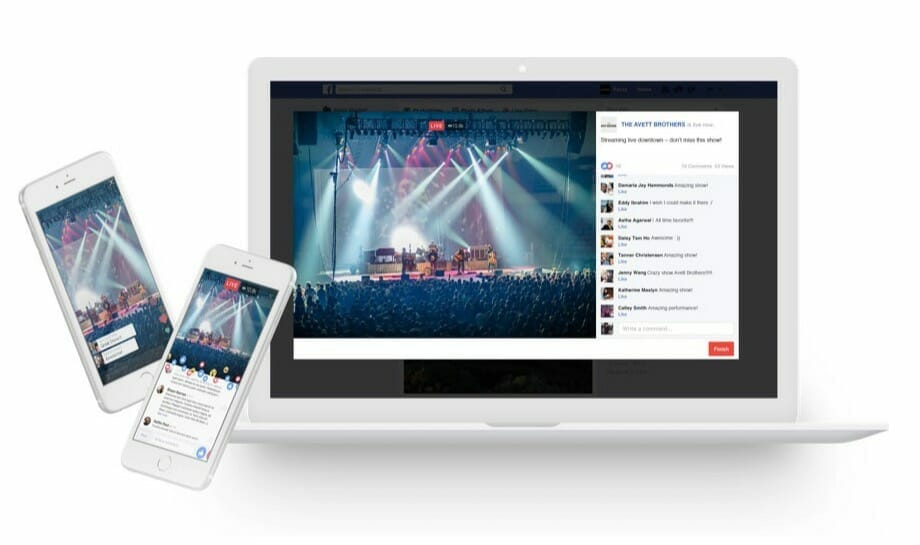

Since its founding in 2004, Vimeo has grown to be one of the most well-known video platforms on the internet. Vimeo made its mark by offering an ad-free experience for video sharing, which made it an instant hit with creators and audiences. Now, it offers live streaming and enterprise video hosting space, with a range of services targeting businesses of all sizes.
The platform emphasis is quality over quantity, which is appealing to many professional creators and businesses. Vimeo offers a cleaner user experience and a vast array of customization options.
Key Features:
- Cloud-based video hosting
- Small-scale streaming solution
- Text and graphic overlay
- Collaboration and interaction tools
- Social share options
- Flexible storage options
Pros:
- User-friendly interface with simple navigation
- Great in-class security and privacy settings
- Good video playback quality
- You can embed your live stream video using this cloud streaming platform on your website
Cons:
- Some issues with connection to an internal server
- No China video delivery
- Limited live streaming and video hosting capabilities
Upload Guidelines and Specs:
- Recommended dimension: 720p (1280 x 720)
- Aspect ratio: 16:9, 4:3
- Max file size: 3GB
- Max video length: Information not available
- Total file storage: Information not available
- Compatible video formats: MP4 (recommended)
Pricing:
Vimeo offers basic video hosting plans that are suitable for content creators and startups.
Pricing if billed monthly, is as follows:
- Free: $0/month; 1 GB storage, creation and editing, screen recording
- Starter: $20/month; 100 GB storage, auto closed captioning, custom URLs and video player, privacy tools
- Standard: $41/month; 1 TB storage, engagement and social analytics, AI script generator, teleprompter, brand kit
- Advanced: $108/month; 5 TB storage, stream to multiple destinations, host live broadcasts and webinars, AI-generated chapters and text summaries
- Enterprise: Custom pricing; more storage and bandwidth, advanced AI capabilities, quality events, dedicated support
All plans are billed annually.
For more details, check out our comprehensive guide to Vimeo Livestream pricing.
Choosing the Right OVP With a Top-tier Live Streaming CDN
For most broadcasters, the online video platform (OVP) they choose integrates a live streaming CDN into its platform. As such, working directly with a CDN for content delivery generally doesn’t make sense, unless you’re a larger-scale enterprise.
Instead, we recommend doing some research to choose the right video host that offers a single-service solution. A single platform with a monthly fee, like Dacast, can handle many or all of your needs in-house. These might include video hosting, video distribution, CDN services, API access, video player, monetization, and much more. Since you depend on a single service to do all these things, choosing the right video hosting platform goes a long way.
We recommend looking for a video hosting service that integrates a top-tier CDN. That’ll ensure maximum reliability and scalability for your online video distribution. Selecting the right online video platform is a big decision.
When evaluating CDN providers, you should consider the following questions:
- Are you planning to distribute live streaming, on-demand video, or both?
- Which file formats will you distribute the content in?
- How many user hours do you expect to require?
- How much do you expect to grow in the future?
- Do you need specific features for monetization or security?
- In which geographic locations do the majority of your viewers reside?
- What’s your budget?
Once you answer these questions, you’ll be well on your way toward deciding which platform makes the most sense for you.
FAQs
1. What does CDN mean?
A content delivery network is a network of interconnected servers and data centers that distribute services to end users. They help improve the quality of streaming by lowering latency hence speeding up your streams and improving their quality.
2. What are the components of a content delivery network?
Most content delivery networks are designed using the following key components:
- Delivery nodes: These are servers that deliver content to end users. They contain caches that run content delivery applications.
- Storage nodes: They store the data that gets distributed to delivery nodes. They can be deployed in a hierarchical way making tiered caching possible.
- Origin nodes: This refers to the main source of content from which distribution occurs.
- Control node: Its core function is to manage, route, and monitor the components of a CDN.
3. How does a CDN work?
CDNs work by minimizing the distance between users and the closest server. Once a user requests a stream, the request goes to the nearest CDN server. So if the CDN server has the requested content, it responds to the request and if not forwards it to the origin server which will handle the request. The CDN server can also cache a copy of the content in case of any future requests
4. Can CDN be used for live streaming?
Video CDNs are designed to improve the quality of streaming experiences. Using CDN to deliver live streams helps your content reach wider audiences by minimizing latency and playback time by ensuring that the origin server is not overloaded with requests.
5. How does a CDN work with a DNS?
Domain Name System translates domain names to IP addresses. Web requests begin with a DNS lookup, therefore, CDNS use DNS for request routing and redirection.
The DNS server will respond based on the requester’s location, referring the user to the nearest CDN server. The DNS server will respond based on the requester’s location, referring the user to the nearest CDN server.
Conclusion
Now you know the basics of live streaming CDN, how it works, and who some of the top players in the industry are. So you can make informed decisions for the uninterrupted delivery of your video and live-streaming content.
Live-streaming is a great way to share your content and experiences with the world, but it requires some technical knowledge to make things easier. A great video hosting platform is another must-have asset that’ll help you in your journey as a content creator.
That’s how you can ensure that you only need to work on improving your creative delivery while Dacast takes care of the technical side of live-streaming for you. So you’re always ahead of your competitors and consistently deliver the quality your audience expects from you.
Online video delivery doesn’t have to be challenging and complex. Using a live-streaming CDN can afford you peace of mind. It ensures that your content never encounters major speed bumps or service disruptions due to server overload.
If you’re still looking for the right live-streaming CDN, take advantage of Dacast’s free trial. Sign up today to enjoy free streaming and all our great features for 14 days. No credit card is required.


